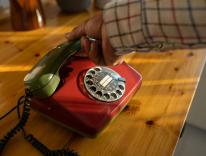The first sign that one is nearing San Giovanni Rotondo, “the city of Padre Pio,” is the shining white façade of the Casa Sollievo della Sofferenza, often referred to as one of Padre Pio’s miracles: a twelve-hundred-bed hospital erected in what was a barren and forsaken spot when Pio first arrived in 1916.
San Giovanni Rotondo was then no more than a hamlet, connected by a flinty path to the Franciscan monastery and the tiny church of Santa Maria delle Grazie. Today, that path is the Viale Cappuccini, lined from end to end with hotels. In 2002, the year of Padre Pio’s canonization, almost seven hundred thousand people visited the town. Little Santa Maria delle Grazie is now dwarfed by the Nuova Chiesa di Padre Pio, a masterpiece designed by one of Italy’s best-known architects, Renzo Piano. Completed in 2004, the church stands over a vast piazza that can hold up to thirty thousand people.
Nowadays you often hear San Giovanni Rotondo compared to Lourdes, and there is no denying that Padre Pio’s legacy is big business. But although you see pictures and statues of him everywhere in Italy, and his image is a constant companion in Italian daily life-in a toll taker’s booth, beside a bank clerk’s workstation-he remains an enigmatic and elusive figure.
Padre Pio was born to a poor family in Campania in 1887. Named after St. Francis of Assisi, Francesco Forgione showed a deeply religious disposition even as a child. As he left home to begin his novitiate in 1903, his mother is supposed to have said, “San Francesco calls you and you must go.” By his own account, Pio received invisible signs of the stigmata as early as 1910 and visible stigmata in 1918. These wounds pained him for most of his life, finally disappearing just before his death. Pilgrims said they could see blood seeping through his fingerless gloves as he said Mass. There are innumerable stories of healings, bilocation, visitations, and levitation.
Padre Pio seems somehow incommensurate with the twentieth century. He lived an austere and fairly solitary life, and endured the kind of mystical torments we usually associate with medieval saints—all against a backdrop of world war and rapid social, cultural, and technological change in Italy. Ordained in 1910, he died just a year before the first Apollo moon landing. Now he has radio and television stations dedicated to him (you can see his image and even hear his voice at www.teleradiopadrepio.it). The stigmata contribute to this sense of temporal dislocation.
Padre Pio himself was largely responsible for the emphasis that was laid on his many sufferings. He once wrote that Jesus told him “I need victims to calm the just and divine wrath of the Father.” He thought of himself as one such victim: in 1912, he wrote to his superior, “Dear Father, I find myself content enough. Jesus does not cease to love me, because he does not cease to afflict me with these ugly brutes” (the brutes being demonic tormentors). Or again: “Bluebeard [the Devil] with many of his kind...has not ceased to beat me, I would almost say to death. But il Monsieur [Jesus] and the other noble personages cheer me with their frequent visits.” Such passages explain why so many images of Padre Pio represent him as one afflicted with extraordinary burdens. The fifth relief panel in the Via Crucis at San Giovanni Rotondo shows him carrying the cross for Jesus in place of Simon the Cyrenean.
Some find the unremitting focus on suffering to be melodramatic and even morbid. St. Francis, after all, was careful to emphasize charity rather than suffering. Still, few deny that Pio’s message and example have given consolation to millions of people, including the many thousands whose confessions he heard. He is said to have spent up to fifteen hours a day hearing confessions. He reached many others through his prayer groups and his letters to his “spiritual children.” Today his work is being carried on by members of his religious community, as well as by those who work at the Casa Sollievo, a house devoted to the relief of suffering.
Fr. Marciano Morra, who knew Padre Pio, writes, “What a difference there is between him and us, who in our little difficulties conclude: God has abandoned me.” But the symbolic power of a saint’s suffering is not just that it throws into relief the triviality of our quotidian worries (which are often far from trivial, as Padre Pio understood). Beyond the saint’s suffering is the sanctity of which it is a sign, and which is still so intensely present for pilgrims to this remote mountainside where he spent five decades. San Giovanni Rotondo is ultimately a monument not to suffering but to the search for spiritual and physical healing.
Please email comments to [email protected] and join the conversation on our Facebook page.
Previous Story
The Other Side
Next Story
Anglican Primates Communique


